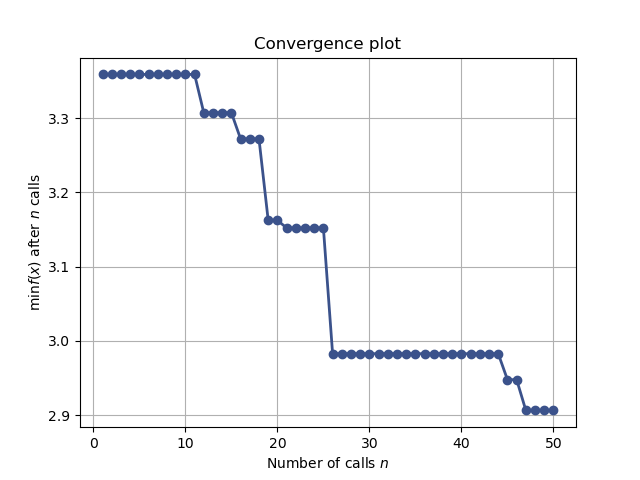Note
Click here to download the full example code or to run this example in your browser via Binder
Tuning a scikit-learn estimator with skopt¶
Gilles Louppe, July 2016 Katie Malone, August 2016 Reformatted by Holger Nahrstaedt 2020
If you are looking for a sklearn.model_selection.GridSearchCV replacement checkout
Scikit-learn hyperparameter search wrapper instead.
Problem statement¶
Tuning the hyper-parameters of a machine learning model is often carried out
using an exhaustive exploration of (a subset of) the space all hyper-parameter
configurations (e.g., using sklearn.model_selection.GridSearchCV), which
often results in a very time consuming operation.
In this notebook, we illustrate how to couple gp_minimize with sklearn’s
estimators to tune hyper-parameters using sequential model-based optimisation,
hopefully resulting in equivalent or better solutions, but within fewer
evaluations.
Note: scikit-optimize provides a dedicated interface for estimator tuning via
BayesSearchCV class which has a similar interface to those of
sklearn.model_selection.GridSearchCV. This class uses functions of skopt to perform hyperparameter
search efficiently. For example usage of this class, see
Scikit-learn hyperparameter search wrapper
example notebook.
print(__doc__)
import numpy as np
Objective¶
To tune the hyper-parameters of our model we need to define a model, decide which parameters to optimize, and define the objective function we want to minimize.
from sklearn.datasets import load_boston
from sklearn.ensemble import GradientBoostingRegressor
from sklearn.model_selection import cross_val_score
boston = load_boston()
X, y = boston.data, boston.target
n_features = X.shape[1]
# gradient boosted trees tend to do well on problems like this
reg = GradientBoostingRegressor(n_estimators=50, random_state=0)
Out:
/home/circleci/miniconda/envs/testenv/lib/python3.9/site-packages/scikit_learn-1.0-py3.9-linux-x86_64.egg/sklearn/utils/deprecation.py:87: FutureWarning: Function load_boston is deprecated; `load_boston` is deprecated in 1.0 and will be removed in 1.2.
The Boston housing prices dataset has an ethical problem. You can refer to
the documentation of this function for further details.
The scikit-learn maintainers therefore strongly discourage the use of this
dataset unless the purpose of the code is to study and educate about
ethical issues in data science and machine learning.
In this case special case, you can fetch the dataset from the original
source::
import pandas as pd
import numpy as np
data_url = "http://lib.stat.cmu.edu/datasets/boston"
raw_df = pd.read_csv(data_url, sep="\s+", skiprows=22, header=None)
data = np.hstack([raw_df.values[::2, :], raw_df.values[1::2, :2]])
target = raw_df.values[1::2, 2]
Alternative datasets include the California housing dataset (i.e.
func:`~sklearn.datasets.fetch_california_housing`) and the Ames housing
dataset. You can load the datasets as follows:
from sklearn.datasets import fetch_california_housing
housing = fetch_california_housing()
for the California housing dataset and:
from sklearn.datasets import fetch_openml
housing = fetch_openml(name="house_prices", as_frame=True)
for the Ames housing dataset.
warnings.warn(msg, category=FutureWarning)
Next, we need to define the bounds of the dimensions of the search space we want to explore and pick the objective. In this case the cross-validation mean absolute error of a gradient boosting regressor over the Boston dataset, as a function of its hyper-parameters.
from skopt.space import Real, Integer
from skopt.utils import use_named_args
# The list of hyper-parameters we want to optimize. For each one we define the
# bounds, the corresponding scikit-learn parameter name, as well as how to
# sample values from that dimension (`'log-uniform'` for the learning rate)
space = [Integer(1, 5, name='max_depth'),
Real(10**-5, 10**0, "log-uniform", name='learning_rate'),
Integer(1, n_features, name='max_features'),
Integer(2, 100, name='min_samples_split'),
Integer(1, 100, name='min_samples_leaf')]
# this decorator allows your objective function to receive a the parameters as
# keyword arguments. This is particularly convenient when you want to set
# scikit-learn estimator parameters
@use_named_args(space)
def objective(**params):
reg.set_params(**params)
return -np.mean(cross_val_score(reg, X, y, cv=5, n_jobs=-1,
scoring="neg_mean_absolute_error"))
Optimize all the things!¶
With these two pieces, we are now ready for sequential model-based optimisation. Here we use gaussian process-based optimisation.
from skopt import gp_minimize
res_gp = gp_minimize(objective, space, n_calls=50, random_state=0)
"Best score=%.4f" % res_gp.fun
Out:
'Best score=2.9062'
print("""Best parameters:
- max_depth=%d
- learning_rate=%.6f
- max_features=%d
- min_samples_split=%d
- min_samples_leaf=%d""" % (res_gp.x[0], res_gp.x[1],
res_gp.x[2], res_gp.x[3],
res_gp.x[4]))
Out:
Best parameters:
- max_depth=5
- learning_rate=0.143650
- max_features=9
- min_samples_split=100
- min_samples_leaf=1
Convergence plot¶
from skopt.plots import plot_convergence
plot_convergence(res_gp)

Out:
<AxesSubplot:title={'center':'Convergence plot'}, xlabel='Number of calls $n$', ylabel='$\\min f(x)$ after $n$ calls'>
Total running time of the script: ( 0 minutes 24.026 seconds)
Estimated memory usage: 31 MB
